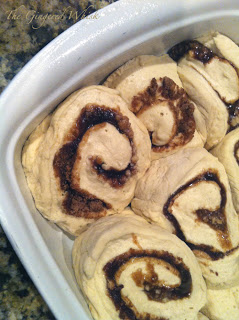Addicting Sourdough Cinnamon Rolls

Let me be super honest with you. These sourdough cinnamon buns are not your average cinnamon roll.

- These long fermented cinnamon rolls take a whopping three days to make!
- The dough is very wet, and very sticky. You need to be familiar with working with high hydration doughs in order to make these.
If that is not your cup of tea, then I suggest checking out my regular sourdough cinnamon roll recipe.
However, if you are ready for a good challenge and want the best dang cinnamon buns of your life, you are in the right place!

These cinnamon buns are worth every second of work, and worth the sticky dough, trust me!
The secret to these super soft, billowy, huge cinnamon buns is … mashed potatoes!
Yeah, I know that sounds really weird, but trust me! The mashed potatoes helps the cinnamon buns stay extra soft, puffy, and billowy.
They are exactly like a big bakery cinnamon bun, but they have that extra special sourdough flavor to them, and are just so amazing.
Other great cinnamon and sourdough bread recipes to try:
How to make these soft sourdough cinnamon buns:
This recipe is very simple to make! Here is a brief overview of the recipe to give you an idea of how it works. For the full set of directions and measurements, please make sure you scroll down to the recipe card below!
Levain:
- Mix the ingredients together in a large bowl. Cover and let sit at room temperature 12 hours (or overnight).
Dough:
- In your stand mixer with paddle attachment, cream the butter.
- Add in the eggs, honey, vanilla and mashed potatoes.
- Scrape down the sides of the bowl and mix until well blended. Swap out the paddle attachment for the dough hook and add the milk and levain, mixing until well blended.
- Gradually add the flour and salt to the bowl.
- Continue mixing with the dough hook until well blended, scraping down the sides of the bowl as needed.
- Allow the dough to rest in the bowl (covered) for 20 minutes.
- After the rest, mix for another 2-3 minutes to help develop the gluten. The resulting dough will be very moist and sticky.
- Turn the dough into a large bowl that has been lightly coated in oil.
- Cover and allow to ferment in a cool location (about 55-65 F) until doubled (this will take 8-12 hours).
- Every 4-6 hours, lift the dough to stretch it, and then fold it onto itself. Each time you do a stretch and fold, you will want to stretch it 3-4 times.
Filling:
- In a medium mixing bowl, combine the melted butter, vanilla extract and heavy cream.
- In another bowl combine the sugar and cinnamon.
Assembly:
- Turn the dough out onto a well floured couche and dust it lightly with flour.
- Roll the dough out into a rectangle (how large you roll it depends on how thick you want your rolls and how many spirals you want).
- Brush the sheet of dough with the butter/cream mixture and then sprinkle with the cinnamon and sugar.
- Roll up the dough, using the couche to help it roll onto itself.
- Using a piece of unflavored dental floss, or a clean thread, cut the log into 12 rolls, about 1.5″ each.
- Place the rolls into a greased baking pan or casserole dish.
- Brush the tops of the rolls with a little melted butter and then cover with plastic wrap.
- Let the rolls proof in the refrigerator overnight.
Baking:
- In the morning, bake the rolls straight from the fridge in a preheated 400 degree oven for 25-35 minutes (if your rolls are really thick it might take a little longer).
- Once out of the oven brush the rolls with a little more melted butter to help keep them soft.
Cinnamon Roll Glaze:
- Whisk together the ingredients, adding just enough milk to make a fluid glaze that flows thickly and smoothly off the end of the whisk. You don’t want so much a thick frosting as you do a nice glaze.
- Use the whisk to drizzle the icing over the rolls and serve warm.
Baker’s Schedule
This recipe takes a bit of time, so its important to understand how the timing will work so you can adjust your schedule. I like to think about when I want them to be done, and then work backwards to know when to start.
Day One:
- Make the levain – 12 hours
Day Two:
- Mixing the dough – 10 minutes
- Autolyse – 20 minutes
- Mixing – 3 minutes
- Proof – 8-12 hours (with stretching and folding every 4-6 hours)
- Assemble the rolls – 20 minutes
- Overnight proof in the fridge – 12 hours
Day Three:
- Baking – 25 minutes
- Cool and frost – 20 minutes
*NOTE: The timing of this schedule is dependent on the temperature of your house. Dough will proof faster in a warmer house, and slower in a colder house. Watch the dough here, not the clock! For reference, the temperature of my house is 70 F.
The Secret to Awesome Sourdough Cinnamon Buns:
Ok, here it is! The secret to these cinnamon buns (and other things)!
Since the dough is so sticky, it is really important to use a well floured baking couche (or a heavy piece of linen or canvas – I have even used a well floured cheesecloth).
Wash it, flour it, and never wash it again. If anything sticks to it, just scrape off anything that happens to cling to it. This is not a good example of one (its a cheesecloth) but it worked.
Using something that is a bit thicker and heavier will work much better, though. You can see how much dough stuck to the cheesecloth, even though it was very well floured.
Then when you are done, shake it out, fold it up, and store it in a ziplock bag. This will save you sooo much hassle and headache, I PROMISE! You can also use this method for making other things, including Povitica!
 |
| I promise that is red thread, and not a hair! Using thread is an awesome way to cut cinnamon rolls, it is so much cleaner! |
Frequently Asked Questions
What kind of sourdough starter do I use for this recipe?
This recipe uses a 100% hydration sourdough starter. That means a sourdough starter fed with equal parts flour and water. For this specific recipe, it does not matter if you use a fed and active starter or inactive discard. Both will work since you are making a levain.
You can use a starter that is fed with any kind of flour. For more information on what that means, make sure to read my guide on how to feed a sourdough starter.
Storage Information
These sourdough cinnamon buns can be stored in a covered container on the counter for up to 3 days.
New to sourdough? Read my Ultimate Guide to Sourdough for Beginners to answer all the questions you have!

Food tastes better when its shared! If you try this recipe, let me know! Leave a comment and rate below! Love and links are always appreciated! If you’d like to share this post, please link to this post directly for the recipe, please do not copy and paste or screenshot. Thanks so much for supporting me! xoxo

Addicting Sourdough Cinnamon Rolls
Ingredients
Levain:
- 150 grams 100% hydration sourdough starter
- 340 grams lukewarm water
- 340 grams flour
Final Dough:
- 113 grams unsalted butter at room temperature
- 3 large eggs
- 42 grams honey
- 24 grams vanilla extract
- 130 grams mashed potato no butter or milk is needed here, just potato
- 195 grams buttermilk or whole milk
- 850 grams of the levain
- 700 grams flour
- 21 grams salt
Filling:
- 170 grams unsalted butter melted
- 85 grams cream
- 600 grams dark brown sugar
- 6 grams cinnamon
- 12 grams vanilla extract
Cinnamon Roll Glaze:
- 3 cups powdered sugar
- 1 TBSP vanilla extract
- ⅓ cup heavy cream
- 2 TBSP whole milk
Instructions
Levain:
- Mix the ingredients together in a large bowl.
- Cover and let sit at room temperature 12 hours (or overnight).
Final Dough:
- In your stand mixer with paddle attachment, cream the butter.
- Add in the eggs, honey, vanilla and mashed potatoes.
- Scrape down the sides of the bowl and mix until well blended.
- Swap out the paddle attachment for the dough hook and add the milk and levain, mixing until well blended.
- Gradually add the flour and salt to the bowl.
- Continue mixing with the hook until well blended, scraping down the sides of the bowl.
- Allow the dough to rest in the bowl (covered) for 20 minutes.
- After the rest, mix for another 2-3 minutes. The resulting dough will be very moist and sticky.
- Turn the dough out into a large lightly oiled bowl.
- Cover and allow to ferment in a cool location (about 55-65 F) until doubled (this will take 8-12 hours).
- Every 4-6 hours, lift the dough to stretch it, and then fold it onto itself.
- Towards the end of the fermentation period you can ready the filling.
Filling:
- In one bowl combine the melted butter, vanilla and cream.
- In another bowl combine the sugar and cinnamon.
- Set aside.
Assembly:
- Turn the dough out onto a well floured couche and dust it lightly with flour.
- Roll the dough out into a rectangle (how large you roll it depends on how thick you want your rolls and how many spirals you want).
- Brush the sheet of dough with the butter/cream mixture and then sprinkle with the cinnamon and sugar.
- Roll up the dough, using the couche to help it roll onto itself.
- Using a piece of unflavored dental floss, or a clean thread, cut the log into 12 rolls, about 1.5" each.
- Place the rolls into a greased baking pan or casserole dish.
- Brush the tops of the rolls with a little melted butter and then cover with plastic wrap.
- Let the rolls proof in the refrigerator overnight.
- In the morning, bake the rolls straight from the fridge in a preheated 400 degree oven for 25-35 minutes (if your rolls are really thick it might take a little longer).
- Once out of the oven brush the rolls with a little more melted butter to help keep them soft.
Cinnamon Roll Glaze:
- Whisk together the ingredients, adding just enough milk to make a fluid glaze that flows thickly and smoothly off the end of the whisk.
- Use the whisk to drizzle the icing over the rolls and serve warm.
Notes
Nutrition
Sourdough Cinnamon Rolls – Slightly adapted from (Not So Humble Pie, Moutaindog @ The Fresh Loaf)

Hi!!! I’m a newbie with a fabulous potato sourdough starter and I’m wanting to make your cinnamon rolls. Do you have a recipe with measurements in cups/spoons instead of grains? Thanks!
Hi Hannah! You bet! I would recommend starting with my other sourdough cinnamon roll recipe (you can search for it with the search box!) This particular recipe you are commenting on uses a high hydration dough and is tricky to work with! The other recipe uses cups as measurements and is much easier to work with!